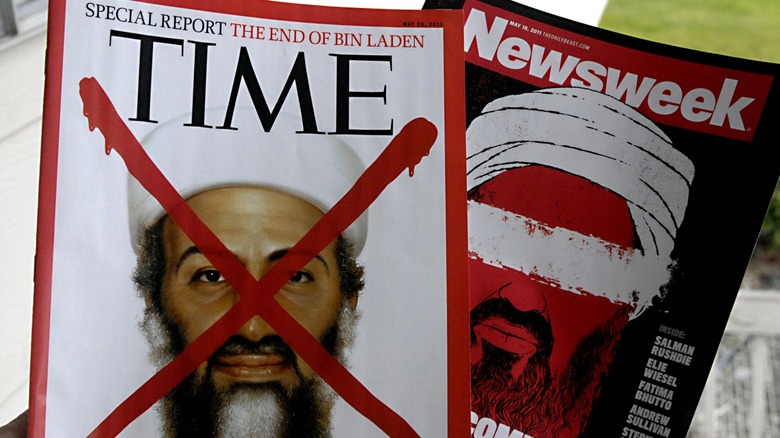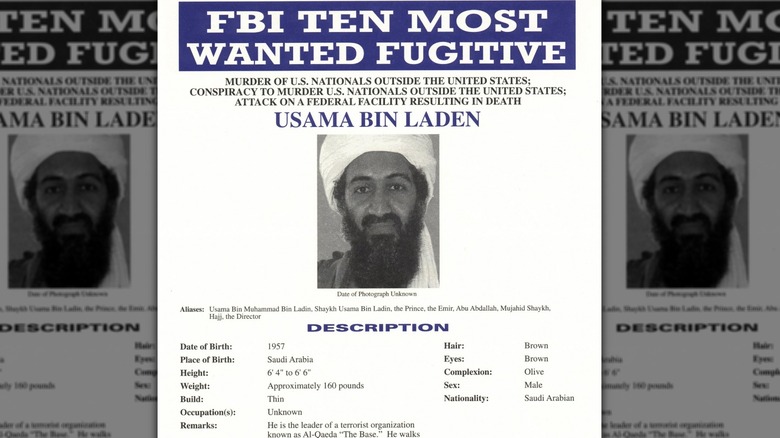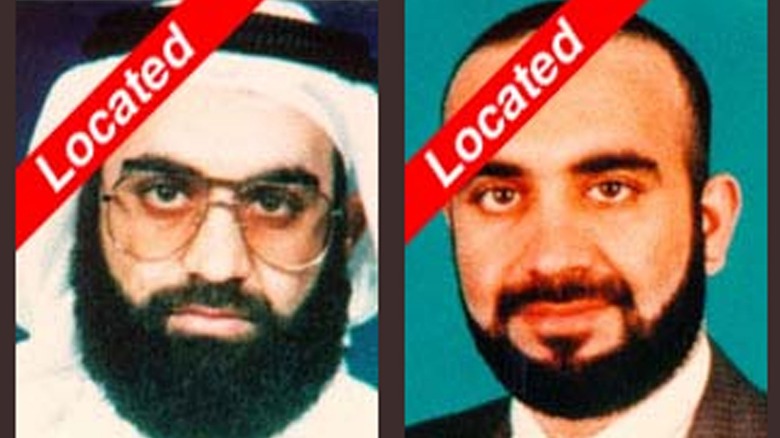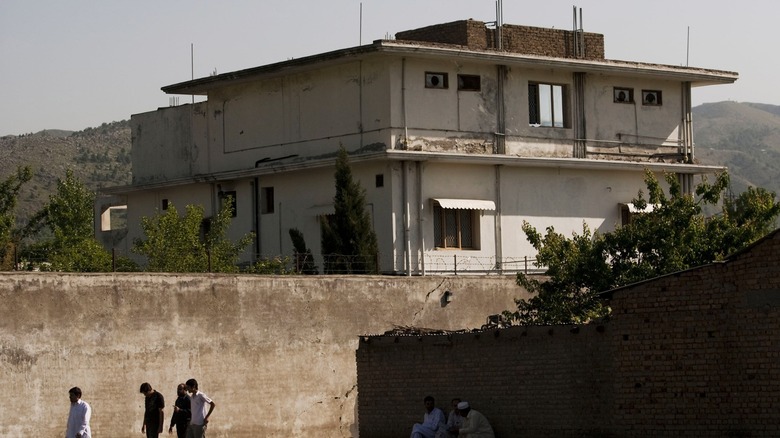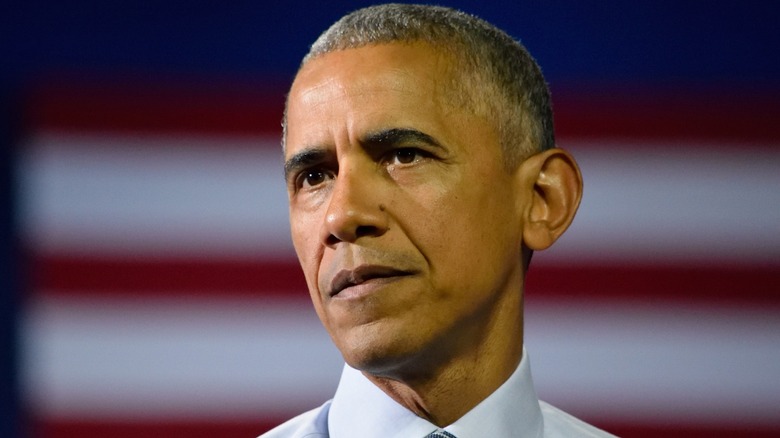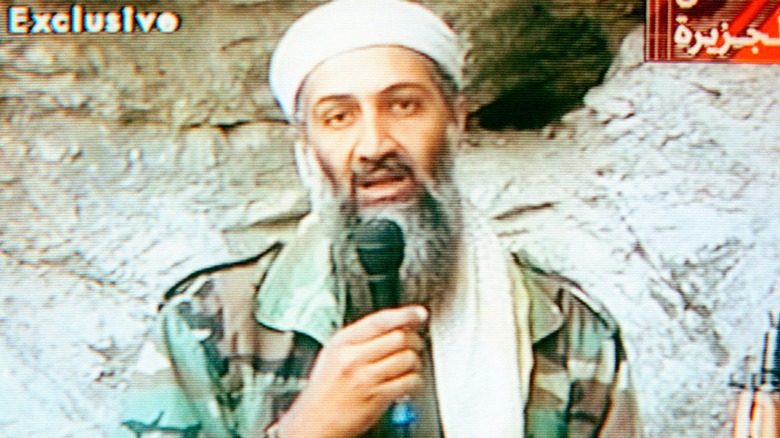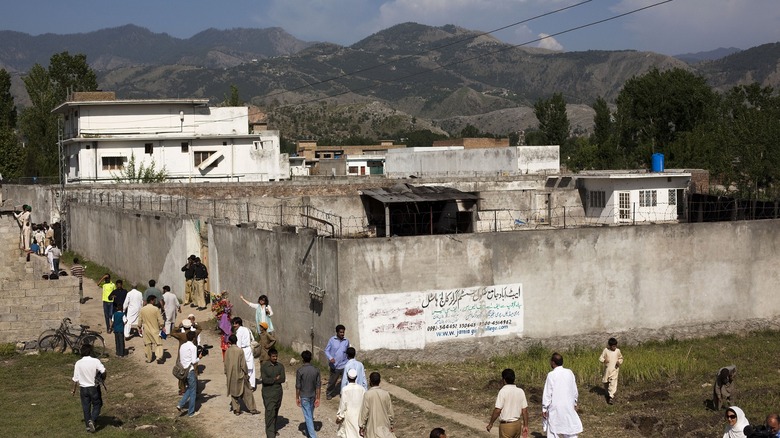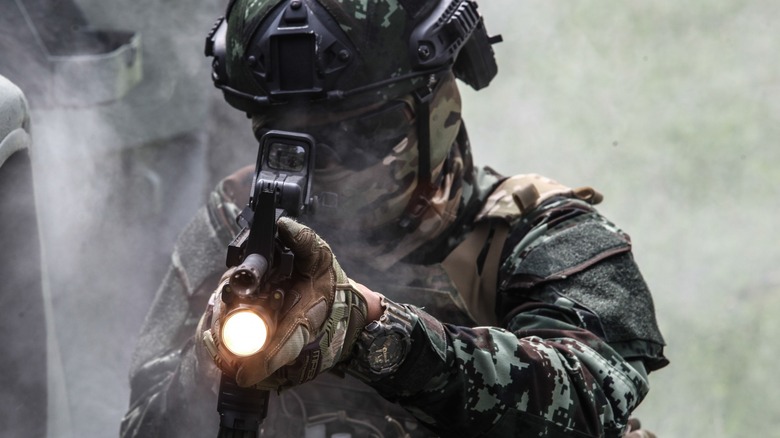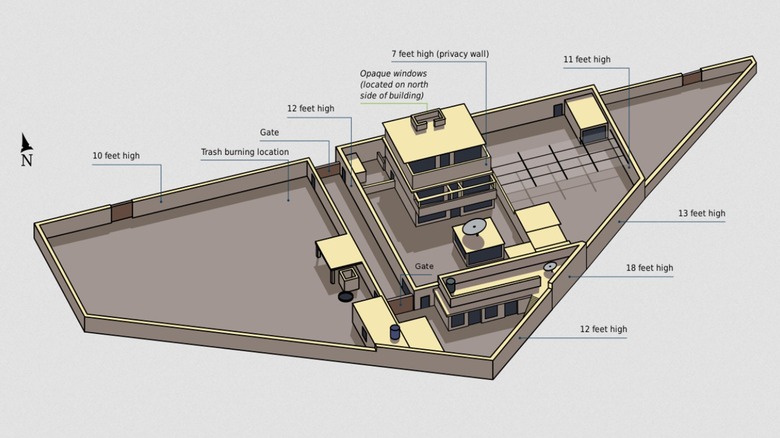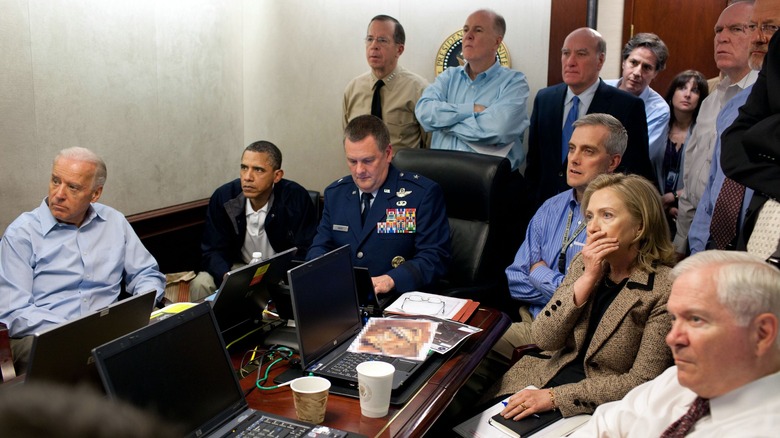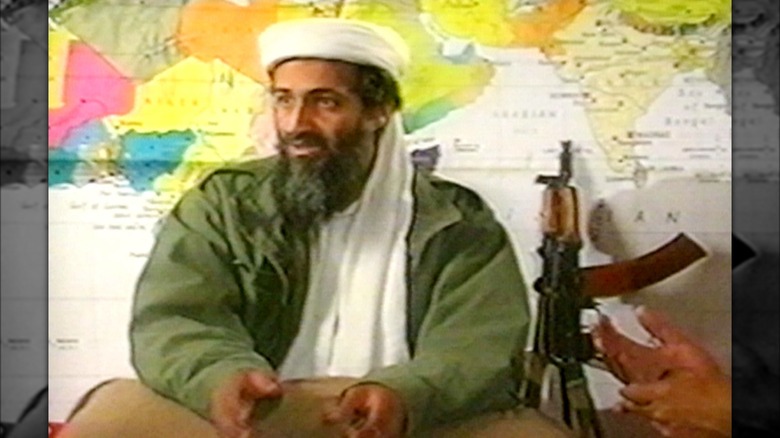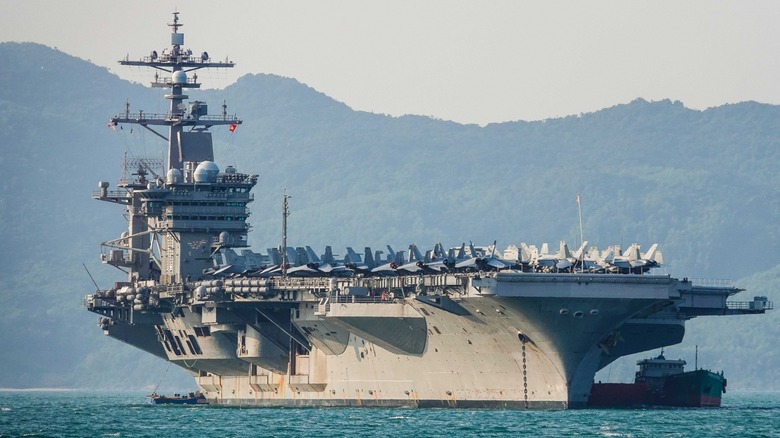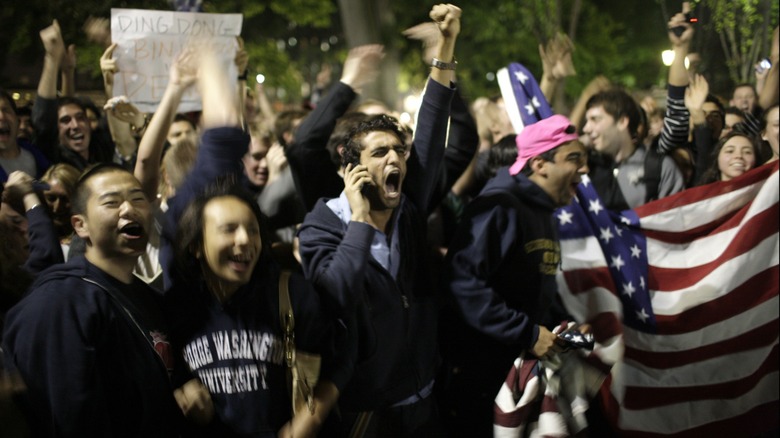The Timeline Of The Killing Of Osama Bin Laden Explained
For many Americans, the name Osama Bin Laden still strikes an emotional chord even years after his death. As the man responsible for the horrifying September 11 terrorist attacks in 2001, few people are as loathed and abhorred in the United States as Bin Laden and his memory.
Before committing the 9/11 attacks, Bin Laden initially began his terrorist activities in the late 1980s, when he created the terrorist organization known as al-Qaeda. Vehemently anti-American and disgusted by the U.S. presence in the Middle East, in the early 1990s, Bin Laden started formulating plans to use al-Qaeda to attack U.S. forces stationed in the area, especially those located on his native Arabian peninsula. By 1995, he was helping to establish terrorist training camps in Yemen and Sudan, and the next year, he declared jihad on U.S. forces. His most infamous attack prior to 9/11 was the 1998 embassy bombings in Kenya and Tanzania, which killed 224 and injured over 4,500 combined, with 12 of the dead being Americans. In addition, al-Qaeda committed other attacks against Americans, including killing 17 Navy sailors in 2000 in a bombing in Yemen.
The year prior, in 1999, Bin Laden had been assigned to the FBI's Top Ten Most Wanted list, solidifying his status as an American enemy. The search for Osama would take many years and be neither quick nor easy, but it would eventually end with his death on May 2, 2011.
The hunt for Bin Laden begins
By the time of the September 11, 2001 terror attacks, the United States had already been after Osama Bin Laden for several years. The U.S. pursuit of Bin Laden may have begun as far back as 1997, a year before a U.S. grand jury officially indicted him for conspiracy to commit terrorism. After the indictment, the U.S. started to offer a hefty $5 million for information about him, and in the wake of the 9/11 attacks, the award was increased fivefold to $25 million.
In addition, the U.S. created a new Most Wanted Terrorist List a month after 9/11, and Bin Laden was immediately placed at its head. They also started planning to invade Afghanistan to capture Bin Laden, after calls for his Al-Qaeda comrades to deliver him to U.S. authorities were swiftly rejected. On October 7, 2001, the airstrikes in Afghanistan started, but by early December, even with Al-Qaeda pushed out of power, Bin Laden was still alive. He had taken refuge in the Tora Bora mountains near the Pakistan border, and U.S. troops were unable to get to him in the rugged territory.
Subsequently, Bin Laden was able to slip across the Pakistan border and escape undetected. Tora Bora represented the U.S.'s closest chance to capture Bin Laden in the aftermath of the attacks, and the government faced extreme criticism for letting him get away. It would be a decade until they got another real shot to take him down.
The long search for Abu Ahmed al-Kuwaiti
With the failure of U.S. forces to capture Osama Bin Laden in the immediate aftermath of the September 11, 2001 terror attacks, the focus turned to finding close associates of his. The thinking was by tracking his confidants and couriers, authorities would eventually come across information about Bin Laden's whereabouts. The investigation would ultimately rely on three important captives: Khalid Sheikh Mohammed (pictured above), Hassan Ghul, and Faraj al-Libbi, all of whom were hardened Al-Qaeda terrorists.
In 2003, through questionable interrogation tactics that included waterboarding Muhammad 183 times, CIA investigators were able to link a shadowy figure known as Abu Ahmed al-Kuwaiti, whose name was circulating among CIA captives, with Al-Qaeda operatives. A year later, Ghul not only confirmed al-Kuwaiti's ties to Muhammad, but also suggested the man was close with Bin Laden and al-Libbi, another high-ranking al-Qaeda member. Finally, in 2005, CIA agents deduced through interrogating al-Libbi that al-Kuwaiti was a major player in Bin Laden's underground terrorist network, and could be used to track him down. They also confirmed his real name: Sheikh Abu Ahmed.
For years, CIA officials knew that Ahmed held the keys to finding Bin Laden, but getting to him was next to impossible. That was until 2010, when investigators identified him on a monitored phone call. Soon, they began to suspect that Sheikh Ahmed and Bin Laden were living together, and that's when the hunt really picked up steam.
Identifying Bin Laden's compound
For the U.S. intelligence investigators trying to find the whereabouts of Osama Bin Laden, leads were scarce. For years, their only real information came from interrogating suspects, sometimes as far away as Eastern Europe, and they had little in the way of physical evidence as to where he might actually be. Yet, once investigators were hot on the trail of Sheikh Abu Ahmed, all that began to change. In July 2010, CIA associates in Pakistan positively identified Ahmed while he was in Peshawar, and soon they began surveillance on his travels.
Eventually, this led them to a compound in Abbottabad, which raised all kinds of red flags. The walls of the compound were very high, much higher than any of the neighbors could see over, and topped with barbed wire, and there were no telephone or internet lines — possibly in an attempt to avoid tracking. The complex had been built sometime in 2004, after Bin Laden is thought to have crossed the border near the Tora Bora mountains, and was known to be home to a pair of wealthy Pashtun brothers, Arshad and Tareq Khan.
It took the CIA a few months to confirm their suspicions, but by February, it seemed pretty clear that Bin Laden was hiding out at the compound. Surprisingly, he was hiding in plain sight, but that wouldn't last long.
Giving the go ahead
Once U.S. authorities were convinced that it was Osama Bin Laden residing at the walled compound in Abbottabad, Pakistan, efforts towards an operation against him went into high gear. By March 2011, President Barack Obama was working extensively with the NSA on a plan, and in late April, he gave the official go-ahead for the assassination to happen. Selected for the mission, which was given the codename Operation Neptune Spear, was the elite Special Forces unit SEAL Team Six (ST6).
Considering the extremely fragile nature of the intelligence and the importance of getting such a high-profile target, U.S. authorities knew they had to work quickly but efficiently to devise a good enough plan in time. Using everything at their disposal, including spy satellites, the CIA was able to draw up a detailed mock-up of the compound, even down to pinpointing Bin Laden's suspected location on the third floor of the main building. The plan was for ST6 to enter the area in two helicopters. The first group was to rope into the compound and take out Bin Laden's suspected associates on the ground level.
The second group was split into two, with half providing external security outside of the compound and half landing on Bin Laden's roof and entering through his balcony to kill him. Speed and precision would be the name of the game, and little could afford to go wrong.
Operation Neptune Spear kicks off
The raid that finally took out Osama Bin Laden was scheduled to begin on April 30, 2011, but was delayed a day due to bad weather. On May 1, SEAL Team Six (ST6) operators took off from their compound in Jalalabad, Afghanistan, and began the journey towards Abbottabad, Pakistan. In addition to the two helicopters scheduled to take part in the actual assault, two reserve helicopters carried additional soldiers and extra fuel in case things went south.
The entire force consisted of 79 U.S. soldiers and a combat assault dog (CAD). The helicopters' codenames were Chalk One and Chalk Two, and the CAD was with Chalk Two as part of the force doing external security. About fifteen minutes after takeoff, ST6 was at the Pakistan border, and it would only be about another hour and fifteen minutes until they reached Bin Laden's suspected compound.
Despite the enormous gravity of the task, most of the ST6 soldiers were incredibly calm on the ride over, with some of them managing to put their nerves aside and even get some sleep. After a while, the compound site came into view, and the Chalk One team prepared to enter. The culmination of more than a decade of searching was finally about to pay off.
A rude arrival
The opening of the raid on Osama Bin Laden's hideout in Abbottabad, Pakistan, kicked off with a bang, just not quite the one the invading U.S. forces were hoping for. As the men in the Chalk One team were preparing to make their roped descent into the compound, the Blackhawk helicopter that was carrying them ran into a problem. Instead of holding steady and allowing the men to repel, the pilot accidentally smashed the tail on one of the compound's walls, sending the chopper careening down.
As the helicopter fell, the members of SEAL Team Six (ST6) who were able to started to jump out, even though it was still about six feet in the air. Incredibly, the pilots managed to maneuver the bird so that none of the spinning rotors made contact with the ground, which would have turned them into deadly flying projectiles. Meanwhile, the helicopter carrying Chalk Two landed the external security force without issue, though they did not drop off the team on top of the compound's roof as planned.
Already, the mission was going well off course, and ST6 was down a helicopter before a shot had even been fired. The noise from the crash torched any notion of secrecy or stealth, likely putting everyone there on high alert. Still, due to their extensive training, the members of ST6 were able to put the setback behind them and continue on with the historic assault.
Conquering the guest house
Following team Chalk One's helicopter crash landing in the compound, the SEAL Team Six (ST6) soldiers on board had little time to spare when turning towards their next objective: neutralizing the guest house. In the guest house was none other than Sheikh Abu Ahmed, the man who had initially led intelligence investigators to the compound the previous August. However, it was thought (and later confirmed) that Ahmed was not living alone, but had several family members living with him.
The presence of family members had both pros and cons for the ST6 soldiers. On the one hand, they assumed that meant the place probably wouldn't have boobytrapped explosives, as Ahmed was likely cautious with having young children wandering around. On the other, it meant they had to be much more careful to prevent any unnecessary civilian deaths from happening.
To gain entrance to the guest house, designated as C1, the ST6 soldiers had to blow open the door with explosives. They quickly exchanged gunfire with Ahmed and his AK-47, ultimately killing Ahmed but not any of his family members, who as it turned out were hiding out in the same room as he was firing from. The first casualty of the raid was now in the books, but bigger things awaited next door in the main building. By now, with all the commotion, the residents had to be aware that something untoward was going on, but their options were dwindling, and fast.
Entering the main building
Once the soldiers from SEAL Team Six (ST6) had taken out Sheikh Abu Ahmed and secured the guest house, the next step was for them to turn their attention to the main target of the raid: Osama Bin Laden. The remaining members of ST6 who had not gone to the guest house instead made their way to the main building, where one team entered on the house's south side.
Inside the house were known to be at least three high-value targets and assorted family members. The men were Ahmed's brother Abrar al-Kuwaiti, Khalid Bin Laden, and his father, Osama, and all of them were assumed to be armed and dangerous. After breaching, the SEALs killed both Abrar and his wife Bushra on the first floor after she tried to protect him, marking the second and third casualties of the operation. By now, only Osama and his son remained upstairs, likely terrified at what was going on below them. The SEALs moved upstairs and quickly took out Khalid, leaving Osama as the lone target still alive on the floor up above.
The U.S. had been searching for Osama for more than 10 years, and here they were, within inches of finally bringing him down. Stripped of his protection and security, Osama would soon come face to face with the Americans he had evaded for so many years.
Killing Osama
After Khalid Bin Laden and both the al-Kuwaiti brothers Abrar and Sheikh Abu Ahmed were dead, there was only one significant target left in the compound, Osama Bin Laden. Very little now stood between him and the SEAL Team Six (ST6) soldiers awaiting him around the corner. It's impossible to know what Osama or the ST6 soldiers were thinking at this point, but they surely contemplated that Osama's last moments were upon them.
The SEALs still had to remain vigilant, as Osama could have easily been preparing one final explosion to take everyone out, but that ended up not being the case. An ST6 soldier took Osama out with a few shots at point-blank range, and just like that, the world's most wanted terrorist was dead. However, the SEALs had little time to celebrate, even though they had just completed one of the most prolific missions in American military history, as they had to quickly identify that the person they had taken out was indeed Osama.
This involved taking DNA samples and clear photos of his body, and they were able to get one of Osama's wives to admit that it was his body lying on the ground. The soldiers quickly radioed back to HQ about Osama's death, who then told President Barack Obama and his advisors the one thing they all desperately wanted to hear: mission success.
Exfiltration
With Osama Bin Laden dead, the members of SEAL Team Six (ST6) had just made history, but they still had a few tasks to complete before they could leave. Besides collecting Bin Laden's body as well as intelligence, the SEALs also had to find a solution for the downed Blackhawk helicopter that was sitting inoperable in the courtyard. Considering they could not exactly call in a tow truck or make the necessary repairs, their only option was to cover it with explosives and blow it up beyond recognition.
They also had to deal with nearby neighbors who heard explosions and gunfire, and wanted to know what was happening. The residents since claimed not to know that it was Bin Laden inside the compound, so to them it was just a random American military strike that involved copious amounts of noise and shouting. A few of them buzzed on Twitter about the raid, but they returned inside and left the SEALs to finish their job. By now, the helicopters supposed to take them home were running low on fuel, and the team also had to be wary about potential involvement from the Pakistani military wondering what was going on.
The entire raid took only about 40 minutes total, half of which was gathering intelligence and escaping the compound. It was a stunning success, with the exception of the lone crash, and soon the soldiers were on their way back to Jalalabad, their mission finally accomplished.
Burying Bin Laden
Following the deadly raid on Osama Bin Laden's compound, U.S. officials were left with the task of burying the body, which proved to be a tricky issue. Not only were officials on a clock, as Islamic tradition mandated the body be buried within 24 hours of his death, but they also had to decide where to put the corpse. The U.S. did not want to give Bin Laden a physical grave with a known location, because they were worried that it would become an attraction for militants and terrorists wanting to pay respects.
This severely limited their options, so they decided that a burial at sea was the best solution. Officials made sure to positively identify Bin Laden's body, then performed the Islamic ritual of ablution to wash and clean the body before wrapping it in a white cloth. He was given last Islamic rites in Arabic, before his body was dropped into an unknown body of water from the U.S.S Carl Vinson (pictured above). Bin Laden's body was seen for the last time on May 2, 2011, and there are no known pictures of his burial that exist.
Announcing to the world
With Osama Bin Laden dead and Operation Neptune Spear complete, there was only one thing left to do: inform the world about the victory. That night, just hours after the raid had been declared a success, President Barack Obama held a special press conference from the White House. He announced the momentous accomplishment, calling Bin Laden's death "the most significant achievement to date" in the fight against al-Qaeda (via The New York Times).
Immediately, the United States was awash in celebration, as the nation's number one enemy since the 9/11 attacks was finally vanquished. The site of the terror attacks at Ground Zero in New York was quickly filled with revelers, who had to temper their extreme jubilation over his demise with their sorrow over the past destruction he had caused. Spontaneous celebrations erupted around the country, and social media was filled with posts talking about Bin Laden's death.
Coincidentally, the next day at Nationals Park in Washington D.C., the Washington Nationals were holding a military appreciation night, which was made all the more special by the news. Fourteen years after it had begun, the hunt for Bin Laden had come to a bloody end.
